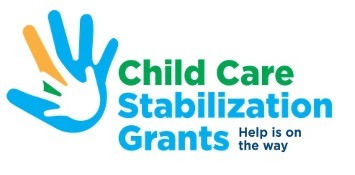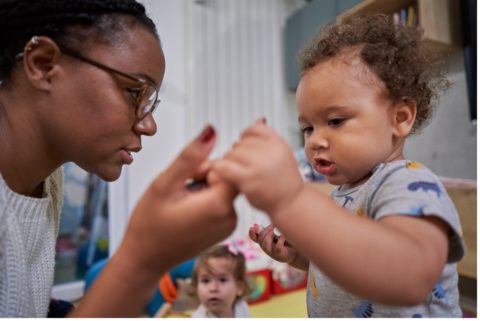Throughout the country, states are disseminating business stabilization grants to child care programs funded through the American Rescue Plan Act (ARPA) passed by Congress in March 2021. It has taken some time because state legislatures needed to approve the use of funding in many states (even though the federal government sent the funds to states), and because states had to design systems to allocate funds equitably based on licensed capacity, enrollment and other factors related to operating a child care program.

Many states have sent funds to programs and others have opened their online applications for stabilization grant submissions. Only a few states have yet to post information online about the application process (i.e., Florida, Missouri and Texas) or otherwise publicize information about the availability of stabilization grants.
Because the operation of any child care program (either in a center or a home) relies on staffing, we reviewed state initiatives to date (as of January 18, 2022) based on publicly available information to better understand specific investments in the child care workforce. Across the country, a tight labor market has made it difficult to recruit and retain staff. For child care centers in many communities, this has resulted in waiting lists for child care because centers can’t open classrooms without sufficient staffing.
The reality is that child care programs must compete against other businesses in the community for employees, many of whom are raising wages, offering bonuses or benefits, that child care programs have been unable to match to date.
American Rescue Plan Stabilization Funds Targeting Early Care and Education (ECE) Workforce Investments
The American Rescue Plan Act allows stabilization funds to be used for:[1]

- Personnel costs (wages and benefits; increases in compensation such as premium or hazard pay; retention bonuses; health, dental and vision insurance; scholarships; paid sick or family leave; retirement contributions; etc.)
- Rent, utilities, facilities maintenance and insurance
- Personal protective equipment, cleaning and other health and safety practices
- Equipment and supplies
- Goods and services
- Mental health services to support the mental health of children and employees
- Paying for past expenses (e.g., child care providers incurred significant financial losses in order to remain in business to serve families in 2020 and 2021), and to the extent possible, relief from copayments and tuition for parents struggling to afford child care
Among allowable uses, and also the first mentioned in the law, is an option for child care providers to support workforce compensation from the grants they receive. Given the low pay across the country for the child care field (the Bureau of Labor Statistics estimates about $12.24 per hour),[2] we reviewed stabilization grants for specific directives for providers to invest in the child care workforce out of their grants.
- Twenty-three (23) states include a specific requirement for stabilization grants to be used to support the ECE workforce — Alabama, Connecticut, Georgia, Hawaii, Kentucky, Louisiana, Maine, Michigan, Minnesota, Nebraska, Nevada, New Hampshire, North Carolina, Ohio, Oregon, Rhode Island, South Carolina, Tennessee, Utah, Vermont, Washington, Wisconsin and Wyoming. For example:
- Georgia and Minnesota require 70% of monthly stabilization grants to be used for workforce support (Georgia also allows these funds to be used to support payments for struggling families not receiving state subsidy).
- Connecticut, Nebraska, New Hampshire and South Carolina require a minimum of 25% of stabilization grants to support the workforce.
- Nevada and Oregon require a minimum of 20% of stabilization grants to be used to support the workforce.
- Rhode Island includes an incentive for a minimum of 10% of stabilization grants to be used to support the workforce.
- Kentucky and North Carolina pay a higher stabilization grant for providers who raise wages (e.g., Kentucky increases grants by 10% if all staff are paid at least $10 per hour and 20% if all staff are paid at least $13 per hour. North Carolina stabilization grants have a two-tiered opt-in for supplemental payments if providers commit to increasing compensation).
- Alabama, Hawaii, Maine, Michigan, Tennessee and Utah include a specific amount to be paid for staff bonuses and/or retention grants.
- Ohio, Washington, Wisconsin and Wyoming include a Staff Retention and Recruitment grant that must be spent on the ECE workforce.
- Vermont requires a commitment to use a portion of stabilization grants for the workforce. Louisiana recommends that all teachers and support staff should receive a stipend, bonus and/or wage supplement.
- At least four states to date have used or announced ARPA funds for direct investments in the workforce (separate from stabilization grants): Illinois, Iowa, Maine and New Jersey.
- Illinois offers a $1,000 one-time bonus for child care workers.
- Maine offers a $2,000 one-time stipend to newly licensed family child care providers.
- New Jersey offers a $1,000 hiring and retention bonus.
- And, Iowa has announced a $30 million Child Care Recruitment and Retention Bonus program with details to be released in February 2022.
- Among 24 states that offer T.E.A.C.H. and/or WAGE$ for the early childhood workforce, 62% have a specific directive to use stabilization funding to invest in the workforce. Excluding Florida and Texas (that operate T.E.A.C.H. programs but have not yet made public stabilization grant applications), the following T.E.A.C.H. states are also using stabilization funding to support the ECE workforce specifically: Alabama, Maine, Michigan, Minnesota, Nebraska, Nevada, New Hampshire, North Carolina, Ohio, Rhode Island, South Carolina, Tennessee, Utah, Vermont and Wisconsin.
- Six states to date have provided increased funding or adjustments for T.E.A.C.H. and/or WAGE$ from American Rescue Plan Act funding: Arkansas ($40 million), Iowa (WAGE$ statewide), Missouri ($1.5 million), Minnesota ($2 million for T.E.A.C.H. and $1 million for REETAIN, the state’s WAGE$ program), North Carolina (removed the income cap for T.E.A.C.H. scholarship eligibility and increased the WAGE$ cap to $23 per hour) and Texas ($7 million).

- Coronavirus Response & Relief Supplemental Appropriations (CRRSA) investment in the workforce. At least 12 and likely more states have invested CRRSA funds in workforce compensation initiatives such as bonus or retention funding: Alaska, Arizona, Colorado, Florida, Georgia, Idaho, Indiana, Maine, New Mexico, Ohio, Texas and Wisconsin. Our review was based on publicly posted information. It is potentially likely that state agencies deleted past initiatives from their websites to reduce confusion between currently open grant opportunities and closed opportunities.
CCSA and its National Center Launch Map for State by State Investments in the Child Care Workforce
Child Care Services Association and its National Center, working with the Early Learning Policy Group, have launched a map with state-specific information focused on the workforce. Check it out and learn more here.
With regard to ARPA stabilization funding, states have until September 30, 2022, to obligate funding and until September 30, 2023, to spend it.[3] With regard to CRRSA funding, states have until September 30, 2022, to obligate funding and until September 30, 2023, to spend it.[4] The American Rescue Plan also included $14.9 billion in supplemental child care funding (in addition to the stabilization funding), which must be obligated by September 30, 2023, and spent by September 30, 2024.[5]
Given the importance of the child care workforce to the availability (and quality) of child care throughout communities, states have time to consider ECE workforce compensation initiatives. Child care workers’ wages should be aligned with the important work that they do. Funding is available. It’s time for policymakers to invest in the child care workforce.
[1] U.S. Department of Health and Human Services, Office of Child Care, American Rescue Plan Stabilization Grant Guidance, CCDF-ACF-IM-2021-02 (May 10, 2021).
[2] U.S. Bureau of Labor Statistics.
[3] U.S. Department of Health and Human Services, Office of Child Care, American Rescue Plan Stabilization Grant Guidance, CCDF-ACF-IM-2021-02 (May 10, 2021).
[4] U.S. Department of Health and Human Services, Office of Child Care, Coronavirus Response & Relief Supplemental Appropriations (CRRSA), CCDF-ACF-IM-2021-01 (April 14, 2021).
[5] U.S. Department of Health and Human Services, Office of Child Care, American Rescue Plan Supplemental CCDBG Discretionary Fund Guidance (CCDF-ACF-IM-2021-03) (June 11, 2021).



